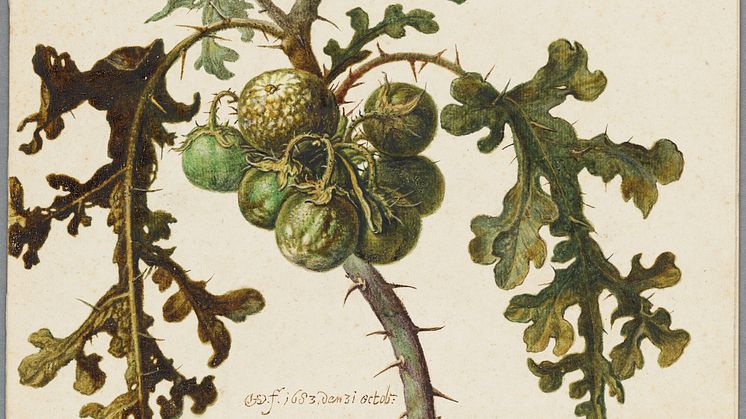
Press release -
New Acquisition: A Botanical Study by Herman Saftleven
Nationalmuseum has acquired a botanical watercolour study by Herman Saftleven from 1683. It depicts a sticky nightshade and was made on commission for Agnes Block, a passionate collector of exotic flora. Only 27 of Saftleven’s botanical studies are known today.
This large watercolour of a Sticky Nightshade (Solanum sisymbriifolium) – a prickly plant with small edible fruits native to South America and Africa – from the I.Q. van Regteren Altena Collection, is a typical example of Dutch artist Herman Saftleven's (1609-1685) sensitively executed botanical studies. Saftleven made his career in Utrecht as a painter, draughtsman, and engraver, principally of landscapes. A prolific artist, he produced around 300 paintings and some 1200 topographical and imaginary landscape drawings. His documentary flower studies, a genre to which he turned late in life, were made on commission for one remarkable patron, the amateur horticulturalist and botanist Agnes Block (1629-1704). Often described as among the most impressive botanical studies in 17th-century Dutch art, they provide a valuable historic record of the intersection of art and science.
Botanical draughtsmanship originated with the development of botanical science and the new fashion of gardening in European humanist and courtly circles in the mid-16th century. By Saftleven's time, it had become a firmly established tradition in the Netherlands. Agnes Block was a passionate collector of exotic flora, which she cultivated in her famous garden at Vijverhof, a country estate near Amsterdam. She owned around 500 different plants and flowers, many from abroad, and enthusiastically commissioned artists to record her collection of natural specimens. Dated drawings by Saftleven show him working at Vijverhof from 1680 until shortly before his death. He produced over 100 botanical studies, only 27 of which are known today.
In the present study, a branch of the sticky nightshade is rendered in trompe-l’oeil, with a clear sense of depth achieved by allowing the fruits and leaves to overlap slightly and employing chiaroscuro effects. The branch has a fully opened blossom, as well as other buds, blossoms, fruits, and leaves in various states of emergence and decline. Its interior make-up is illustrated by a cross-section at the bottom. The florid cursive signature of the artist, documenting the date of completion, 31 October 1683, complements the elegant arabesque of the branch. Earlier in the same month, Saftleven had painted a different specimen of the nightshade family, a Madagascar Potato, today in the British Museum.
Although seemingly naturalistic depictions, such studies are in fact idealized versions of reality. Based on multiple studies from life, they are composites designed to communicate all known information about a flower in a single image. The function of adapting reality in this way was not simply a project of beautification, but primarily as a tool for effective scientific record. Block's patronage of Saftleven and other botanical artists served to transform her plant specimens into images that are both documents and striking works of art.
Nationalmuseum’s acquisition of this work has been made possible by a bequest from the Wiros Fund. Nationalmuseum has no budget of its own for new acquisitions, but relies on gifting and financial support from private funds and foundations to enhance its collections of fine art and craft.
Press contact
Carina Fryklund, Senior Curator, Collections and Research, carina.fryklund@nationalmuseum.se, +46 8 5195 4475
Press officer, press@nationalmuseum.se, +46 767 23 46 32
Categories
Nationalmuseum is Sweden’s premier museum of art and design. The collections comprise older paintings, sculpture, drawings and graphic art, and applied art and design up to the present day. The museum building is currently under renovation and scheduled to open again in 2018. In the meantime, the museum will continue its activities through collaborations both in Sweden and abroad as well as temporary exhibitions at Nationalmuseum Design at Kulturhuset Stadsteatern in Stockholm. Nationalmuseum has partnerships with Svenska Dagbladet and the Grand Hôtel Stockholm, and acknowledges the support of FCB Fältman & Malmén.

